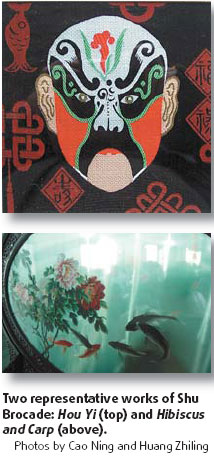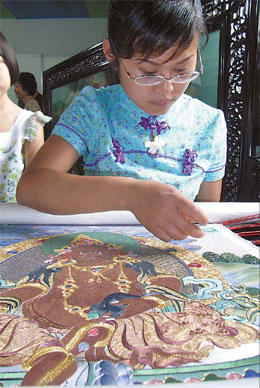Looming large
CHENGDU: Chinese newlyweds once received a very special gift on their wedding night. Friends and family presented the couple with a brocade silk bedcover featuring a dragon (symbol of the male) and phoenix (female). But like many Chinese traditions, younger people are turning to modern styles. Duvets are more appealing to young couples.

Help is on the way and Professor Tu Hengxian is in high spirits. The 61-year-old teaches at the College of Textiles of Shanghai-based Donghua University (former China Textile University) and is in Chengdu, capital of Southwest China's Sichuan Province, to help the Shu Brocade Academy prepare its new museum due to open next April.
Tu and his colleagues are also giving suggestions on the museum's style of decoration as well as its interior design.
Tu started studying the Shu Brocade, the oldest of China's three schools of brocade, in 1982. Over the years, he has visited Chengdu many times, leading Chinese and overseas students to study and restore ancient Shu Brocade.
With an investment of 20 million yuan ($2.7 million) from the Chengdu Shu Brocade Cultural Development Co Ltd, the museum will exhibit historical documents, cultural relics and their replicas with live demonstrations of brocade weaving.
Tu is also a member of an expert panel under the Ministry of Culture to select items applying for their inclusion on the list of China's intangible cultural heritage.
"The relics and their replicas include wood looms from different dynasties in Chinese history," says Zhong Bingzhang a leading official with the Chengdu Shu Brocade Cultural Development, which runs the Shu Brocade Academy.
Together with the Song Brocade of Suzhou in East China's Jiangsu Province and the Yun Brocade of Nanjing in Jiangsu, Shu (the ancient name for Sichuan) Brocade is the oldest school from which the other two evolved.
In the late Qing Dynasty (1644-1911), Chengdu had more than 2,000 private workshops and more than 10,000 looms producing brocades. The State-owned Shu Brocade Plant was set up in 1951 with more than 2,000 weavers.
But today, the number of master weavers "can be counted on two hands", says Xie Huiru, an 80-year-old master weaver of the plant.
"To cater to public needs, the plant specialized in mass production of silk for clothing and bedcovers," he says.
"It introduced mechanical production in the early 1960s, because manual weaving took more time and its cost was higher. Eventually, hand weaving was replaced with mechanical production in 1966," Xie recalls.
From the early 1950s until the early 1990s, the plant's products sold well. But after 1995, market changes led to its shutdown in 2003.
Another market that dried up was in neighboring Japan.
"A large number of brocades from Chengdu was exported to Japan, but as the number of Japanese dressing in kimonos dropped, so did their demand for brocades," says Wang Guilin, chairman of Chengdu Shu Brocade Cultural Development Co Ltd.
With the aim of saving the ancient craft from extinction, the Chengdu Shu Brocade Cultural Development Co Ltd restored mechanized production in the former Chengdu Shu Brocade Plant.
Dahualou, which literally translates as big jacquard platform, is a wood loom built during the reign of Emperor Jiaqing of the Qing Dynasty in the late 18th century.
"Made entirely of wood, dahualou has not a single nail to connect different parts. It can be detached and reassembled easily," Huang says.
There are only three original dahualou looms still in existence in the country. They are in the National Museum of China, Sichuan Provincial Museum and the Shu Brocade Academy, Huang says.
Huang, 67, has worked for more than four decades for the former Shu Brocade Plant, first as a weaver, then technician, deputy chief and general engineer. The Shu Brocade Academy has made five replicas of the dahualou looms, he says.
|
In 1951 the Shu Brocade Plant had more than 2,000 weavers. Now the number can be counted on two hands, but of late, youngsters from rural areas have been showing an interest in the traditional wood looms. |
"Because of the dull routine and low pay, only poor people learned brocade weaving in the past. To find a bowl of rice to fill my hungry stomach was the only reason I learned brocade weaving at the age of 11. Nowadays, few young people want to be brocade weavers," Xie says.
In an effort to preserve the tradition, the Chengdu Shu Brocade Cultural Development Co Ltd has invited seven retired employees of the former Chengdu Shu Brocade Plant to teach young interns.
At an average age of 75, the seven including Xie come at irregular intervals to guide young interns.
Two years ago, six youngsters aged 18 from rural areas came to learn the traditional wood looms. "They have mastered the looms and can weave some simple patterns," says He Bin, a 42-year-old weaver in the academy.
Son of a retired weaver in the former Shu Brocade Plant, He began to learn the trade at the age of 17.
The local government plans to raise 30 million yuan ($4 million) to invest in a series of schemes so that Chengdu can properly live up to its accolade of Brocade City.
Among the proposed programs is the creation of more readily marketable new brocades, which can be used for interior decoration, garment trimmings and luxury lining and the establishment of Shu Brocade Street near the academy.
(China Daily 09/11/2007 page19)















